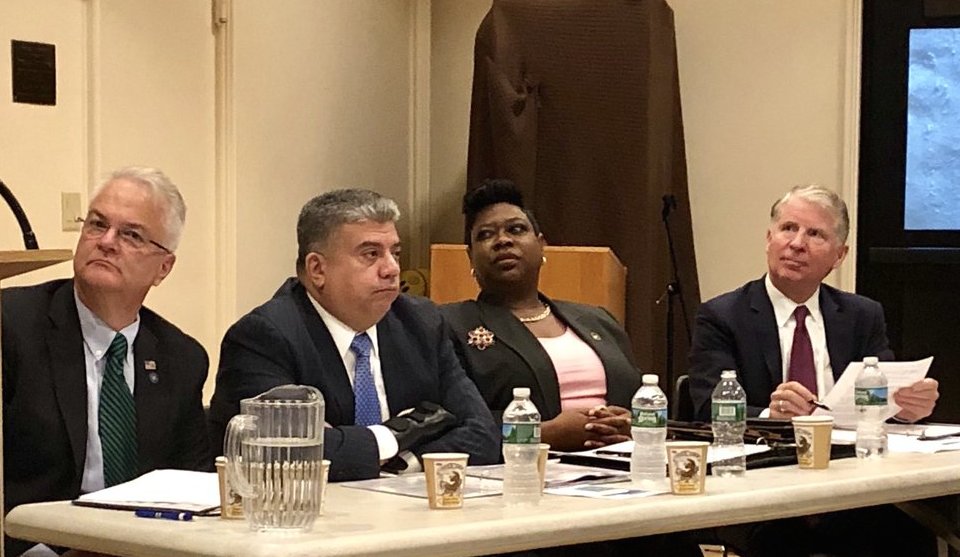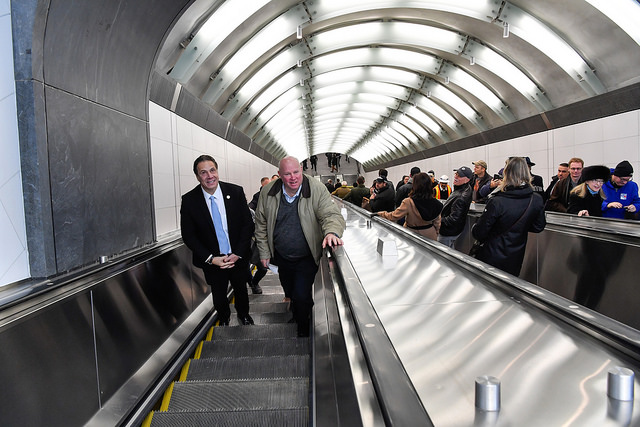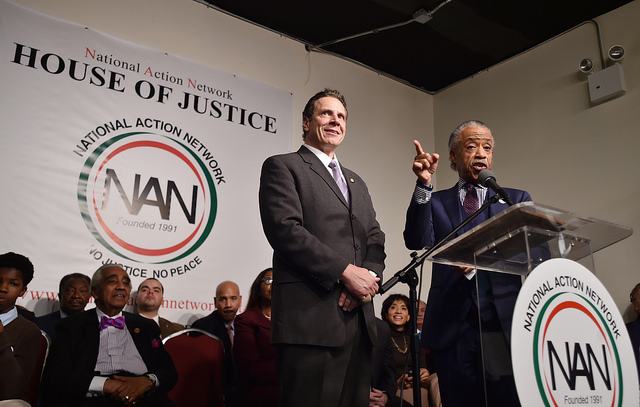The Next Step to Reform District Attorney Campaign Finance

Four NYC DAs (photo: @ManhattanDA)
For the past four months, the people of Manhattan have grappled with accusations of their District Attorney cultivating a pay-to-play culture in which the rich and powerful skate by serious criminal charges -- if their lawyers contribute sizable donations to DA Vance’s campaign. In a public display of penance for allowing the appearance of corruption to permeate, Vance requested The Center for the Advancement of Public Integrity at Columbia Law School to investigate ways to better insulate our elected prosecutors from the influence of donors. The CAPI recommendations make for a good headline after months of bad PR for the DA, but will not change the status quo.
Following the report, Vance said he will adopt the ‘blind’ practice used for judicial candidates who are raising money for their campaigns. Unfortunately the failings of this model are widely known, and are surely no secret to Vance himself. It follows a legal fiction that removing the DA from the fundraising eliminates the potential conflict. That is absurd.
It is pure fantasy to suggest a candidate will have no knowledge of who is donating to their campaign. Full transparency is an ideal all elected officials should be striving for in our electoral system, especially when it comes to the funding of campaigns. That is why the records of who has donated to candidates are fully public, easily obtained by the click of a button. There’s no ‘blind’ approach to raising money when the names, addresses and amount of money donated are so easily accessed by the public, press, campaign, and candidates. Especially for a DA like Cy Vance who has been in office for almost a decade and has built a donor list based on strong relationships with certain criminal defense lawyers and law firms.
Then we come to the donor cap recommendations -- riddled with far too many loopholes. By restricting the $320 donation cap to only attorneys appearing before the DA office, the policy is extremely limited, allowing many other non-appearing attorneys from the same law firm to donate individually up to $3,850. Undoubtedly, high-profile wins for firms are good for business. Perhaps that’s why Marc Kasowitz, Trump’s personal lawyer, had his coworkers raise over $18,000 for Vance just a few months after the DA chose not to prosecute the Trump children. Under the CAPI recommendations, this could continue to happen. In fact, under Vance’s new self-imposed fundraising rules, he would only have to wait six months after a case is resolved to accept donations from the exact lawyers who appeared before his office.
Even with the cap from partners and some lawyers, there are a multitude of ways that law firms with an attorney or attorneys who appear before the DA office can donate significant amounts of money to the DA. It will just take some creativity. This permits the existence of the conflict that CAPI admits exists -- attorneys donate to create "positive relationships" with the DA's office, "which, could, in theory inspire some of them to become contributors to the DA's campaign." An understatement to say the least.
The CAPI recommendations represent an incomplete addition to the conversation of reforming the way we fund our DA races, something the report acknowledges. This report should not signal the tidy conclusion of how the rich and powerful were seemingly able to curry favorable treatment through campaign donations by their lawyers. We need true comprehensive reform to make our system one New Yorkers can confidently rely on. I have legislation that will bring us one step closer to this by forbidding large donations to DAs from criminal defense lawyers or their law firms. Let’s get this passed and move toward a fairer system for all.
***
Dan Quart is a member of the New York State Assembly representing Manhattan’s East Side. On Twitter @AMDanQuart.
***
Have an op-ed idea or submission for Gotham Gazette? Email This email address is being protected from spambots. You need JavaScript enabled to view it.
With MTA Facing Massive Shortfall, A Lot Riding on New Congestion Pricing Push

Gov. Cuomo in the subway (photo: The Governor's Office)
Governor Cuomo’s “Fix NYC” commission produced a framework for a congestion pricing plan, released just after the governor’s Executive Budget for the 2018-19 Fiscal Year, which begins April 1. The congestion pricing framework outlines a three-year phase-in that would provide revenue of $1 billion to $1.5 billion a year starting in 2020, most of which would be intended for the MTA Capital Plan.
That is also the year the MTA must begin its next five-year capital plan for continued investment in the upgrade and preservation of the subway, bus, and commuter rail systems. The current $30 billion plan, the 2015-19 plan, faced a shortfall of $15 billion when initially proposed in 2014, and it was not until 2016 that the governor and the Legislature finally adopted a framework for that plan. The 2020-2024 plan likely faces a similar funding shortfall of $15 billion, so money flowing from a congestion pricing program for the MTA in 2020 would arrive just in time to fill much of that shortfall, although the Fix NYC framework did not outline a specific disposition of the money from a congestion pricing set-up.
A November 2017 report by State Comptroller Tom DiNapoli, “ Financial Outlook for the MTA,“ stressed that the MTA’s capital funding shortfalls could be even larger than $15 billion because more than $7 billion in the 2015-19 plan that the state government committed to providing the MTA still does not have an identified funding source.
Beyond that, MTA Chair Joseph Lhota’s Subway Action Plan Phase Two indicated a need to add $8 billion in capital funding for the subway system. The MTA is not under an obligation to offer the details of its 2020-2024 Capital Plan until the fall of 2019 so it is not clear how all these unmet needs and proposals might fit together. But a shortfall of more than $20 billion is likely.
The comptroller’s office suggested the MTA accelerate the release of the details of its 2020-24 plan to enable greater public engagement in the process of coming to terms with these important decisions. The MTA should do this -- the governor, the Legislature, and the public need to get a handle on what the MTA thinks is needed sooner rather than later. (The comptroller’s report confirmed the concerns raised in my September column: “The MTA’s Long-Term Financial Problem is Severe and May Soon be Worse.”)
If the Legislature does not enact a formidable congestion pricing plan, worth $1 to $1.5 billion a year, enough revenue to support $10 billion or more in bonded funds for the mass transit system, or find some other alternative, it will be catastrophic for the subway, bus, and commuter rail systems, the fundamental infrastructure that allows for the wealth of the New York City metropolitan area. In fact, even if the proposed congestion pricing plan is adopted, the MTA’s greater than $20 billion shortfall would only drop by half and there would still be $10 billion to find unless the federal government were to step in to provide much larger amounts of money than at present.
Mayor de Blasio’s proposal to tax millionaires was envisioned to raise $750 million a year, with $500 million to fund $8 billion worth of bonds for the MTA, and $250 million to subsidize low-income New Yorkers’ subway and bus rides with half-fare MetroCards. Together the congestion pricing plan and the millionaires tax might raise nearly $20 billion for the MTA, coming close to closing the gaps in meeting mass transit capital needs.
Both proposals face significant opposition in the Legislature, from State Senate Republicans opposed to the millionaires tax, to everyday legislators of both parties who simply don’t wish to impose new charges or fees on their constituents to drive into Manhattan, either because they feel the charges are unfair or won’t solve the congestion problem.
Governor Cuomo has not yet submitted a bill to the Legislature that provides the details of the congestion pricing plan or how the money would be used. He has said he wants to discuss the issue with the Legislature first, although he has embraced the concept advanced by Move New York that the tolls on the outer borough bridges that don’t feed the Manhattan central business district should be reduced. That means some of the Fix NYC revenue would be diverted to reduce those particular tolls and not available to the MTA for its capital needs.
The governor has also submitted bills in the budget to force New York City government to come up with much more money for the MTA, a move the de Blasio administration is strongly opposing.
One bill would force the City to pay the 50% of Chair Lhota’s Subway Action Plan that the chair had demanded of the City and that Mayor de Blasio had refused to pay. Another bill would give the MTA the power to create special districts in New York City where subway expansions add property value and allow the MTA to obtain portions of city property taxes related to the new value created for the MTA Capital Plan. The concept was used to pay for the 7-train extension by dedicating revenue from property in the Hudson Yards area to cover the costs, although that plan was a creation of the City of New York and the City controlled the dispositions of funds, unlike the governor’s proposal here, where it does not appear the City would have a say in the matter.
Another Cuomo budget bill is perhaps the most dramatic of all -- it says the City of New York must pay the full cost of the New York City Transit Authority capital plan. The City of New York has a seat on the MTA Capital Review Board and a vote on the New York City Transit Authority Capital Plan, so it has the power to veto that part of the plan. This power does not quite fit with the obligation to fund the plan, nor does it square how parts of the New York City Transit Authority Capital Plan might get funded from other sources of revenue and how the City negotiates the package. The MTA’s capital needs are so immense it is reasonable to ask New York City government to increase its contribution, perhaps even in a major way, but the governor’s proposals are orders rather than requests and may simply be opening gambits for negotiation.
Another major issue is the gargantuan expense of the MTA’s construction programs and purchases. A recent New York Times series described the immense waste of funds in the projects. The MTA, the governor, and the Legislature cannot ignore the problem -- the size of the MTA’s needs just costs too much money and the City and State just can’t afford to write checks to cover $20-30 billion shortfalls.
Right now congestion pricing is the main issue on the table. Mayor de Blasio and the Legislature should support it.
Governor Cuomo and Mayor de Blasio should bury the hatchet, at least as far as the mass transit system goes. There needs to be a consensus about addressing the giant shortfalls faced by the capital needs of the system. It’s also worth mentioning that both former Mayor Bloomberg and the newer Move New York plan sought to use congestion pricing funds to improve express bus service in areas of the City poorly served (or not served at all) by the subway system, and that issue, among others, certainly needs to be taken into account.
The MTA needs an astonishing $2 billion a year in new sources of revenue for the cash and debt service on bonds to cover more than $20 billion needed through 2024-25. If congestion pricing fails and there is no meaningful replacement the prosperity and public safety of the metropolitan area will be threatened.
***
Jim Brennan was a member of the New York State Assembly for 32 years, where he chaired four committees. On Twitter @JimBrennanNY.
***
Have an op-ed idea or submission for Gotham Gazette? Email This email address is being protected from spambots. You need JavaScript enabled to view it.
Dr. King Wanted Housing Justice That Governor Cuomo Must Deliver

Gov. Cuomo receives an award, 2016 (photo: Kevin P. Coughlin/Governor's Office)
Governor Cuomo recently gave his 2018 State of the State address. Like years past, he highlighted his accomplishments and reminded New York of the “historic commitments” he’s made to solve our most pressing issues. High among those issues was -- and remains -- homelessness. He called on our “compassionate society” to care for the homeless and, discussing criminal justice reform, invoked the late Dr. Martin Luther King, Jr., quoting, “Justice too long delayed is justice denied.”
I agree, Governor Cuomo: New Yorkers are compassionate; homelessness is wrong; and it is the government’s job to meet the needs of all New Yorkers. And in the spirit of Martin Luther King, I would add that it is the community’s responsibility to hold government accountable when it is not meeting the needs of its people.
I am homeless. For the past two years I’ve been staying on friends’ couches and in shelters while I look for housing. At this year’s State of the State address, I joined the Upstate Downstate Housing Alliance coalition, and was one of the 24 people who were arrested while blocking the entrance of the State Capitol. Despite freezing temperatures, New Yorkers from around the state met there to protest Governor Cuomo’s housing failures.
Governor Cuomo’s record on housing has hurt New Yorkers. Tenants are not able to keep up with rising rents, our scarce public housing is deteriorating, and our state has more people homeless than ever on record.
A recent U.S. Department of Housing and Urban Development issued report says that 88,352 people slept in shelters across New York State on a given night last January -- and there are many more, uncounted. Under Governor Cuomo’s watch, the state’s homeless population has swelled by several thousand.
At this year’s State of the State address, the Governor reminded us of his 2016 commitment to invest $20 billion to confront homelessness and create affordable housing. He went on to promise to build on his commitment but provided no details. I cannot help but question whether money will actually materialize and if the housing will ever be built. For nearly two years, we’ve witnessed delays in funding and only partial allocations of the resources we so desperately need.
Governor Cuomo did provide clarity on one thing, however. He threatened to strip local governments of funding for homelessness services if cities fail to conduct effective street outreach programs. This comes at a time when the State has already failed to fairly share the costs of sheltering people with local governments. While street homelessness is a problem that every city should be prepared to deal with, it simply isn’t possible to do without the State’s support.
As always, the question of money will arise. We have already heard phrases like “budget deficits” and “tough decisions,” which only translates to continued homelessness and desperation for those of us living the policies we hear debated.
The truth is, we have the resources to pay for ending the homeless crisis right here in our State.
New York is home to Wall Street, billionaires, millionaires, and real estate developers -- some of the wealthiest people and institutions in the world. With the right tax and budget policies, we could ensure that vital housing programs are funded and that truly affordable housing gets built for low income people. And with political will and bold leadership, we could slow the continuous stream of low-income New Yorkers who are moving from permanent housing into shelters, by expanding protections for tenants, at no cost at all.
We have some room for hope. Unlike previous years, at this year's address Governor Cuomo committed to closing the carried interest loophole -- a provision in our tax code that gives the wealthiest people in our state massive tax breaks. Closing this loophole would generate billions of dollars for New York, protecting us from the Trump Administration’s disastrous tax and budget policies. We’ll wait to see if Governor Cuomo moves words into action, and truly aligns with New Yorkers who support economic fairness.
Ahead of the Governor’s presentation of his budget plan and on the heels of the Martin Luther King Day, let’s hope Governor Cuomo remembers the more than 88,000 people who are homeless across the state. Let’s hope he makes the investments we so badly need. And let’s hope he remembers that Dr. King dedicated his life to demanding justice for all.
***
Georgia Morgan is a member of VOCAL-NY, a grassroots organization that builds power among low-income people impacted by homelessness, HIV/AIDS, drug use, and mass incarceration. On Twitter @VOCALNewYork.
***
Have an op-ed idea or submission for Gotham Gazette? Email This email address is being protected from spambots. You need JavaScript enabled to view it.




